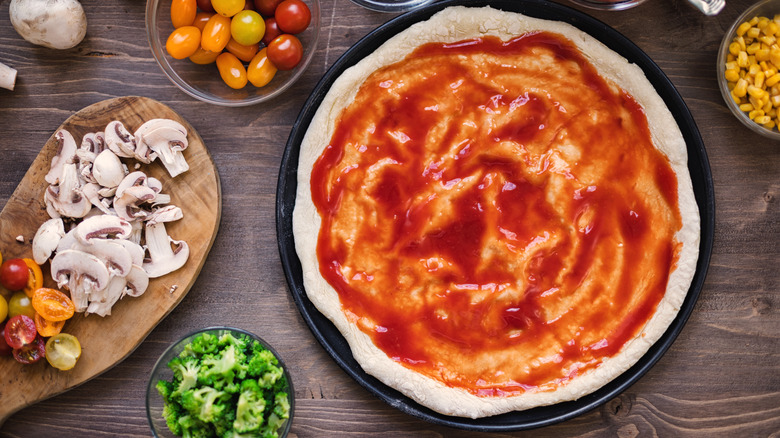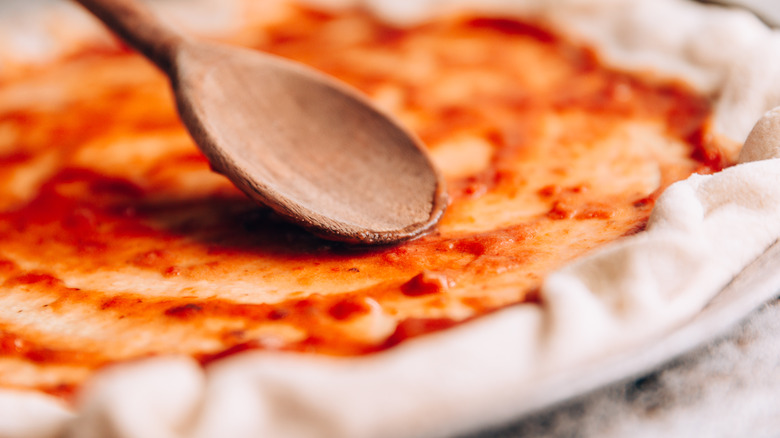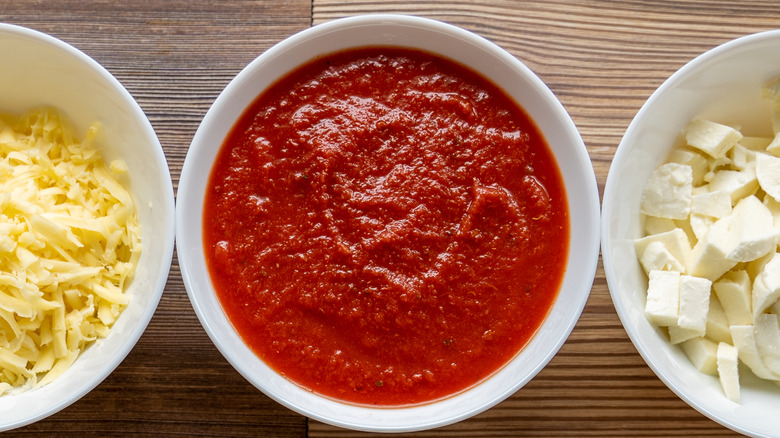The Expert-Approved Sauce Ratio For The Best Homemade Pizza
While restaurant pizza seems to have the perfect ratio of gooey, salty cheese to hearty tomato sauce, getting that same balance with homemade pizza can often be tricky. Sometimes, you can wind up with a pie that's too tomato-y, while other times you might find you're lacking the acidic notes that the sauce adds.
So, how do you get the right sauce-to-pizza ratio? Marc Forgione (@marcforgione on Instagram), chef and restaurateur of Respect Hospitality Group, which consists of Trattoria One Fifth (@onefifthnyc), Peasant, and the soon-to-reopen Forgione, sat down in an exclusive interview with The Daily Meal and gave us some insights.
Forgione explains that you might not need as much pizza sauce as you think you do and says, "At Trattoria One Fifth, we use two ounces of sauce on a 12-inch pie." That's just around a ¼ cup, which sounds like very little, but its rich flavor goes a long way.
Finding the right balance of sauce and toppings
Although Marc Forgione explains that two ounces is right for a 12-inch pie, as you adjust the size of your dough, you may not know how much sauce to use. Luckily, he explains what to look for to determine whether you've got enough sauce: "That should be just enough to cover the bottom of the dough and hold the ingredients. In general, less is more when it comes to ingredients, and use the saying, 'high-quality versus high-quantity ingredients.'"
In fact, it's not just the sauce that you want to be wary of overloading your pizza with. You may also want to limit the number of toppings you use. Adding up to five toppings at a time can be a great way to get a burst of flavor without affecting how long the pizza needs to cook. If you use more than that, you may find your toppings and dough don't cook at the same rate, leading to a crust and fixings that are either burnt or undercooked and soggy.
What goes into the sauce matters, too
Besides getting the right amount of sauce on your pizza, it's also important to get the ratios of ingredients in it balanced as well. Marc Forgione explains that one of the biggest missteps someone can make with pizza sauce at home is "making it too sweet." Some people add a bit of granulated (or even brown) sugar to their sauce to help level out the acidity of the tomatoes and make the topping more balanced. However, if you go overboard, that flavor can become cloying. If you're going to add it, you don't need as much as you might think. Try starting with about ½ teaspoon per serving of sauce. You can always add a bit more if you need to.
You can also skip the sugar altogether and focus on other add-ins to bring a boost of flavor to your pizza. For instance, add some balsamic vinegar to homemade pizza sauce to brighten up the flavor and add a dash of sweetness. Another choice could be to upgrade it with a dash of red wine. This enhances the tomatoes' flavor and can add hints of things like chocolate, cherry, and oak. Or, stir a bit of parmesan cheese into your pizza sauce to give your sauce an umami kick that ups the savory flavor of your pie. Whichever way you go, there are plenty of options for upgrading your sauce's flavor while heeding Forgione's advice to avoid using too much.


